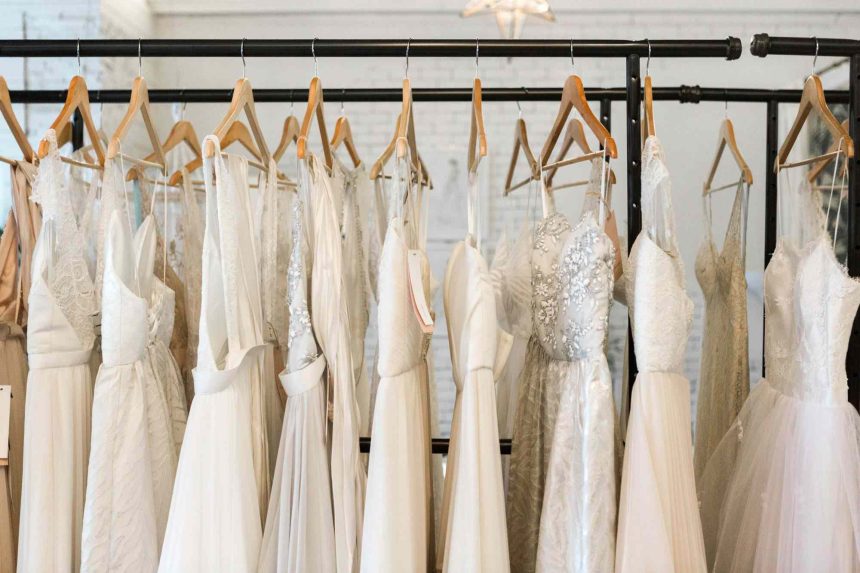Planning a wedding is an exciting journey, and one way you can fuel that joyful energy is to score a gorgeous wedding dress at the thrift store for way less than you’d pay at a bridal boutique. “Wedding gowns are the stuff of dreams, magic, and sparkle. Unfortunately, they’re only worn once,” says PJ Gach, a fashion expert and author of The Grumpy Fashionista. “Whether you’re a bride who wants to wear a vintage gown from the 1940s or the latest designer creations, you can find it in a thrift store. Thrifting for a wedding dress is a thrilling adventure.”
If you’re hoping to find an incredible wedding dress at the thrift store, follow these expert tips to find a unique treasure (that earns you bonus points for sustainability).
Familiarize Yourself With Different Styles
This Modern Romance
Before setting out to find your dream second-hand wedding dress, give yourself a little educational rundown on the styles of the decades so that you can spot your preferred era in the racks, advises Samantha Davis, a thrifting expert and owner of Vintage Boss Babes. This is especially handy when perusing a brick-and-mortar vintage or consignment store since you can ask the clerk if they have anything from your preferred decade.
Here’s a quick rundown provided by Davis:
- The 1950s would typically have voluminous skirts as well as tightly fitted waistlines and a decorative neckline.
- In the 60s, we saw many brides getting married in shorter hemlines, even above the knee.
- In the 1970s, cottagecore style was all the rage, and this style translated to wedding dresses. Think empire waists and flowing sleeves.
- We all know that the ‘80s were famous for big shoulders and even bigger wedding dresses.
Thrift During Off-Peak Wedding Season
One of the best-kept secrets in bridal shopping: timing is everything. “The off-peak wedding season, typically November through March, is your golden window, with January being the holy grail,” says Edward Reyes, founder of conSHINEment. “Most boutiques and retailers are clearing out their inventory during this time, often donating excess gowns to thrift stores for tax purposes. Translation? January is when you’ll find the biggest selection of dreamy gowns at unbeatable prices.”
This may vary slightly depending on where you live. For example, peak wedding season in Arizona is October through May, but once summer hits, no weddings are happening. In this case, you’d time your search for mid to late summer.
Don’t Rush It (or Get Discouraged)
Unless you’ve found the absolute perfect dream wedding dress while thrifting—or the cost is inconsequential—don’t feel like you need to purchase the first dress you see. “Secondhand wedding dresses are not the most popular items sold at thrift stores, so even if you find a few on your first day looking, they will most likely be there at least a few days, if not a few weeks, into the future,” Davis says. “Ask the store associate how often they change the floor so that you have an idea if you need to come back sooner rather than later to grab a dress that may have caught your eye.”
In that same line of thinking, don’t give up quickly, either. Gach reminds us that most thrift stores rely completely on donations and that every week brings new stock. “If you don’t find a wedding gown on your first foray into thrifting, don’t give up,” she says. “Visit thrift stores in your area on a regular basis, and you will find your dream gown.”
Research the Label
Kyle John Photography
Not every wedding gown at the thrift store will have a label—but if it does, take some time to research the brand. It’ll give you better insight into the era and quality, as well as materials used, all of which can inform your purchase. It may even give you an idea of just how much money the gown is worth and if you’re getting a great deal.
If you don’t see a label on the top near the back neckline, look along the inner seams of the gown, particularly near the waist or side zipper. Some labels are tucked away in less obvious spots.
Try It On (or Measure It)
If you’re shopping at a thrift store that allows you to try on garments, make sure to do so before purchasing. This will give you a better idea of how well the garment fits and how extensive the alterations may be. If the store doesn’t allow try-ons, consider wearing a tank top and leggings so you can try the dress on over your clothes.
Another option is to take your own measurements and then measure the garment itself. “Bring a tape measure to measure things like bust, waist, shoulders, and length,” Davis says. “The size in an older wedding dress will not necessarily reflect modern sizing today. Oftentimes, we see a vintage size 12 from the 1960s, which actually best fits approximately a size 6 today.”
Inspect the Garment Inside and Out
While wedding dresses are only worn once, they really go through the ringer on a wedding day. Trains often drag along the ground, they’re danced in all night long, and they may even have food stains on them. Take care to inspect the gown completely, both on the exterior and interior.
“For any gown, inspect the dress’s exterior from the neckline to hem. Check seams, lace, beading, attached crinoline, and all decorations for damages,” Gach says. “Turn the dress inside out and re-inspect everything. Minor stains on the dress and underarm area can generally be fixed by taking the dress to a good dry cleaner specializing in stain removal.”
If the wedding dress is in a keepsake box, ask the store clerk if you can open it to inspect the gown. If they cannot or will not open the keepsake box—and the dress looks like it’s a winner—Gach says you can take a gamble if the price is right.
Assess for High Quality
Rachel Thurston
When thrifting wedding dresses, prioritizing quality ensures you find a gown that not only looks beautiful but will hold up through your big day. Start by assessing the fabric: Natural fibers like silk or lace often feel luxurious and hold up better over time. Also, check the construction by turning the dress inside out; high-quality gowns have neatly finished seams and secure stitching.
Examine embellishments like beadwork or embroidery to make sure they’re sturdy and intact and not beyond repair, and double-check that zippers and buttons work. You can also focus on the weight, feel, and overall condition of the gown to ensure it’s a worthy investment.
Avoid ‘Wounded Birds’
Davis says that the term “wounded bird” is a common one in the vintage and secondhand industry. “Sometimes, we find a garment that has a flaw—such as a tear, stain, or something else that shows significant enough damage that the item needs repair,” she says. “Even if you fall in love with a secondhand wedding dress, I would seriously reconsider your purchase if it requires significant repair.”
This is particularly true if you don’t have a lot of time between your wedding day and the purchase, or if you want to keep your costs low.
Gently, but firmly, pull on the fabric. “This helps you check for dry rot—a common issue in older dresses,” Reyes says. “If the fabric tears easily, it’s unfortunately beyond saving. But if it holds up, congratulations! You’ve found a dress with plenty of life left in it!”
Factor In Dry Cleaning and Alterations
New wedding dresses are notorious for long lead times, sometimes requiring as much as four to six months before delivery. Though you can pluck a secondhand dress right from the rack, you should still factor in time for cleaning and necessary alterations. This can take anywhere from a few weeks to a couple of months, depending on the complexity of the alterations and the availability of your seamstress or tailor.
Also, factor in the cost when considering your overall budget. “One of the issues I see is that brides forget the cost of alterations and dry cleaning and imagine that their second-hand dress will cost absolutely nothing when in fact, there does need to be a financial investment to make the dress ready for their wedding day,” Davis says.
Contact local dry cleaners and tailors specializing in wedding dresses and inquire about average prices so you’re not sticker-shocked and can budget accordingly. Also, “If you’re looking to do extensive alterations,” advises Holly Chayes, a personal style coach at Who Wears Who, “make sure there is enough extra fabric, like a long train or an extremely full skirt, to do the alterations you’re looking for.”






